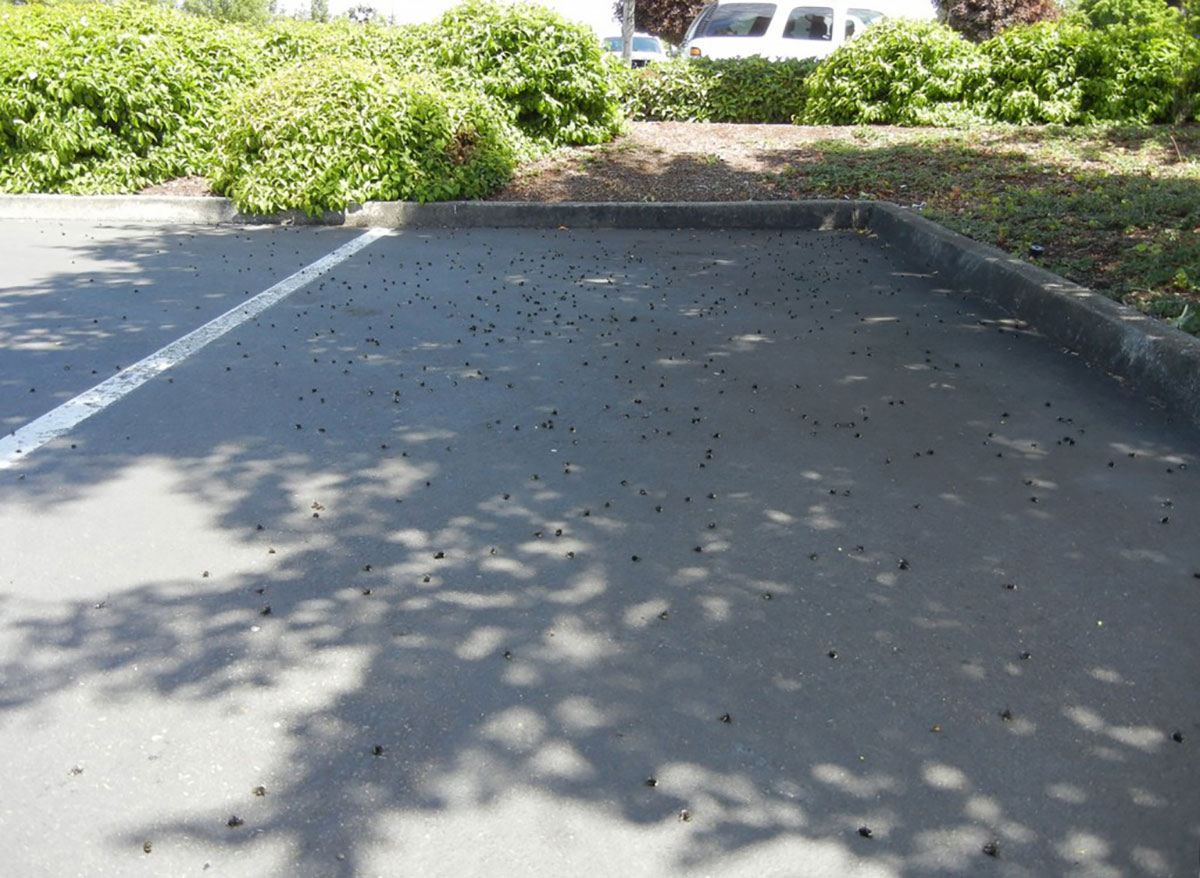Midsummer days were sticky back in Chicago, with tiny spatters of honeydew covering Mom’s sunny yellow Chrysler. It was shady on our driveway under the trees and no one bothered about the sticky car except to wash it every now and then when Mom asked, using the occasion to blast the Beach Boys or the Rolling Stones from the 8-track tape player in her car. I never thought to wonder where the honeydew came from.
When tragedy struck the bees of Wilsonville
Fast forward decades to Pollinator Week, June 2013. The news came on the radio announcing 50,000 dead bumble bees found in Wilsonville, Oregon. Linden trees in a shopping center parking lot, heavy with flowers, had been sprayed with a neonicotinoid insecticide early in the morning. Bees foraging a few hours later, hungry for that midsummer nectar, spun drunkenly and fell to the ground, motionless. Although some later incorrectly blamed a sugar called mannose in the linden trees, state testing showed that the linden flowers contained enough neonic to kill bees seven times over. The bees’ bodies were saturated with pesticide, containing more in each bee than what the Environmental Protection Agency already knew was lethal.
The pesticide had been sprayed on the trees by a landscape company, to keep shoppers’ cars from getting sticky with honeydew produced by aphids in the trees above. As the news reverberated around the world, it sunk in: a town just miles from Xerces headquarters was now the site of the largest mass death of native bees due to pesticides ever in America.
Shockingly, the Wilsonville bee kill was just the first of six bumble bee kills associated with neonic usage on linden trees in Oregon that summer and the next. Only two of the six incidents were related to faulty or reckless application (spraying during bloom); the rest were tied to legal applications of soil drench, bark spray, or injection applications of neonics weeks or months earlier.

Far from a nuisance, honeydew powers the insect world
When we think about the Wilsonville event, we can’t help but wonder ”what if.” What if the landscapers, and the rest of us, had understood more about honeydew? What if they had understood that pesticides should never be sprayed on blooming plants, and that there might be other ways to manage—or even thank—the insects that produce honeydew? Unfortunately, pesticides can be a bad idea no matter when applied. Applications of systemic insecticides even outside of bloom can linger in plants, affecting pollinators. Systemics even wind up in honeydew excreted by hemipterans feeding on these plants, killing hoverflies consuming it.
Many insects like aphids and scale insects secrete honeydew after feeding on plant sap, and even some caterpillars produce it, especially members of the gossamer-winged and metalmark butterfly families. Honeydew’s sweet taste attracts a wide variety of insects to feed, with some considering it the most important carbohydrate source in many agricultural systems. Honeydew also supports beneficial predators and parasitoids who keep pest insects in check.
Bees and some butterflies also feed on honeydew. The importance of honeydew for bees and other beneficials varies around the world, and in different seasons. One of our favorite stories is about beekeepers in Turkey and Greece, where the honey bee is a native species. They don’t just bring their honey bee hives to forests full of honeydew in order to sell special, supposedly-delectable “honeydew honey,” but they even manage the forests to increase honeydew availability!
Although honeydew isn’t as nutritious as pollen or nectar, it seems to be an important food source for some pollinators during droughts or periods with low nectar production. Sometimes wasps and ants even compete to collect honeydew, as part of a larger phenomenon of ants protecting honeydew producing insects from other predators in order to keep their monopoly on those sweet sugary secretions. We think this is one of the coolest multi-species interactions we know!

Beyond the nectariferous lindens, honeydew is also often associated with conifers, like fir and pine, and with keystone wind-pollinated species like the magnificent oak tree. These wind-pollinated species are often overlooked as important for pollinators, but that’s probably because these connections are more subtle. The Northern Oak Hairstreak butterfly has been observed collecting sugary secretions from galls made by cynipid wasps, and collecting honeydew–perhaps even to the degree that it does not need nectar! Now that’s a big support to a beloved pollinator.
It’s been ten years since that Wilsonville tragedy. We’ve talked a lot since about the hazards of pesticides and we’ve made some progress. Still, few people really know the secrets of honeydew. And sadly, the number of dead bees from the Wilsonville incident has been revised upward, to possibly more than 100,000.
It’s so important that we not only recognize the danger of pesticides, but also cultivate curiosity about other animals, and appreciate and value what insects do… even if it makes our cars and decks occasionally sticky. Can we all accept a little inconvenience now and then to support the little things that run the world?
Learn More
- Learn more about the the Wilsonville bee kill
- Learn more about the risks of systemic insecticides
- Read The Surprising Culinary Delight of Honey Dew, aka Plant Bug Poo, by Jennifer Frazer, complete with videos! Don’t miss this, it’s wonderful!
- Read about how honeydew has served as food for people too, including Native Americans and early Mormon settlers.



